Since the founding of our website over 10 years ago, classic men’s style has always been our forte–and classic style for women a hotly requested topic! So today, we’ll discuss the reasons why the two fields are so different, and why we haven’t (and most likely won’t) start a “Lady’s Gazette.”
- Reason #1: It’s Simply Not Our Area of Expertise
- Reason #2: There Was No True “Golden Era” of Women’s Fashion
- Reason #3: Women’s Trends Are More Extreme Than Men’s Trends
- Reason #4: Women Have A Broader Wardrobe Today
- Reason #5: Womenswear Garments Tend Not To Last Long
- Classic Women’s Style Resources
- Outfit Rundown
One of the reasons we love classic men’s style is that it’s just that — classic. When referring to clothes, “classic” typically means a garment or design of an elegant style that is not greatly subject to changes in fashion. About three times a week we get asked if there is a Lady’s Gazette, why we haven’t started one, if we can point people in the right direction, and why we are not covering women’s topics in the first place. Unfortunately, we can’t and won’t venture to oblige to you. Here are our reasons why!
Reason #1: It’s Simply Not Our Area of Expertise
As a regular follower of the Gentleman’s Gazette, it probably won’t come as a surprise to you that we consider ourselves to be experts in classic men’s style. However, that shouldn’t suggest that we’re 100% clueless about women’s styles through time! In fact, it’s the knowledge we do have that’s convinced us that a Lady’s Gazette wouldn’t be the thing for us.
Women’s style, in terms of how it evolved, what materials are used, and how it fits is just an entirely different ball game compared to classic men’s style. Also, the further you go back in time, the less overlap there is between classic men’s and classic women’s garments. On top of that, the Gentleman’s Gazette was born because classic men’s clothing and style were my hobby and they became my passion. In my spare time, I would travel to see craftsmen such as tailors and shoemakers, simply to learn more about the garments and the items, as well as the craft.
We believe there are far more qualified women and men out there who can speak on the subject of women’s clothing and style and I urge you to seek them out. That being said, do we know the equivalent website or channel to the Gentleman’s Gazette for women? Sadly, we don’t and we’ve never encountered one–but we’ll share a list of YouTubers that can point you in that direction towards the end of this post.
Classic style doesn’t really work in the same way for women…
Now that we’ve stated the main reason why we don’t cover classic style for women, let’s dig a little deeper. Frankly, my wife and business partner Teresa and I have gone over this question for years. Together, we’ve come to the conclusion that classic style simply doesn’t work for women in the way that it is for men and there are a few reasons why. Of course, Teresa and I collaborated on this post because we felt it was important to have the input of a woman who wears women’s attire and who wishes there were more classic items for women.
To illustrate this point, let’s take a closer look at these two images of the fashion couple powerhouse from the 1980s and ’90s, Prince Charles and Princess Diana. Charles could wear the exact same ensembles today and not look dated in the slightest. On the other hand, the same cannot be said for Diana who was a fashion icon in her own right in her day. In no way do I mean this to reflect personally on either Charles or Diana, it’s just a really good point to show how differently women’s fashion and men’s fashion have evolved over the course of 30 years.
So, why is it that most people from today’s point of view would describe Charles’ outfits as “timeless” and Diana’s as “dated?” First of all, we believe it is because there is no foundational garment in a woman’s wardrobe today. Unlike in menswear where the suit has been a foundational garment for the better of a century, you do not have this clothing piece in women’s wardrobe today. You may argue that that’s not really true but if you look at, for example, a pair of jeans or khakis or a suit, they’re all very similar. For men, it typically consists of a pair of pants and a shirt and maybe a jacket.

Most garments that men wear are just a variation on those three things. You might say, what about that dress? Yes, in the 1950s, the dress could have been considered as a foundational garment in a mainstream women’s wardrobe but that is no longer true because there are many women who would never think about wearing a dress or a skirt, for example.
So aren’t pants a foundational garment for women today? Actually, pants for women weren’t even really acknowledged until the 1930s. Of course, women have lots of choices. They can wear pants, rompers, skirts, dresses, shorts, jumpsuits, and many other things but none of those is foundational. Because of that, it’s difficult to say what is classic and what isn’t when there’s so much variety and certain fashion periods favor one over the other.
Reason #2: There Was No True “Golden Era” of Women’s Fashion
At least in my mind, unlike in classic men’s fashion, where maybe the 1920s and 1930s are considered by many to be the Golden Era, you don’t really have a comparably strong decade in women’s wear. Though just like in menswear, the modern era also started for women in the 1930s. As a result, women’s fashion today is often a mix of styles that appeared in the last 70 to 100 years.
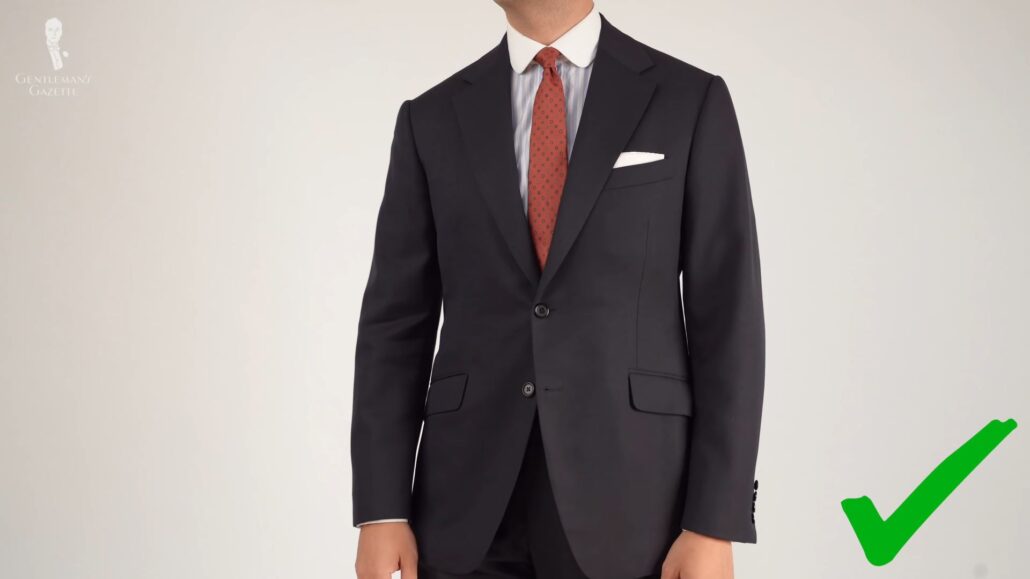
To be fair, men’s fashion and trends are likewise often a composition or a mix of what has been around in about the same time frame. That being said, if you stay clear of the extremes in menswear, meaning you avoid five-button jackets with super wide or super skinny lapels, and you go with a medium-wide lapel and maybe two buttons, you’ll have something that won’t look dated throughout the decades.
Reason #3: Women’s Trends Are More Extreme Than Men’s Trends
Because of that, women’s fashion that is more than 20 years old often looks more vintage or costume-y because they just went all in one direction and that, in turn, makes it much harder to come to the middle to find a classic look that can be worn throughout the decades. For example, if Teresa and I go to a vintage store, we can shop for clothes from the same era and hers will always look much more costume-y, vintage, and very specific to a time period compared to the stuff that I can find.
So, why exactly is that the case? Well, first of all, I think women often wear patterns or certain colors on much larger surface areas. If maybe a floral print is popular in menswear, you can just find it on the tie, not in a suit whereas for women, they would have the pattern printed all over. On top of that, concepts of fit for women have been much more extreme. Just think about the oversized look for women that you may sometimes see in the ’90s or maybe the ’80s and that is really absent for men, except maybe looking at the zoot suit.
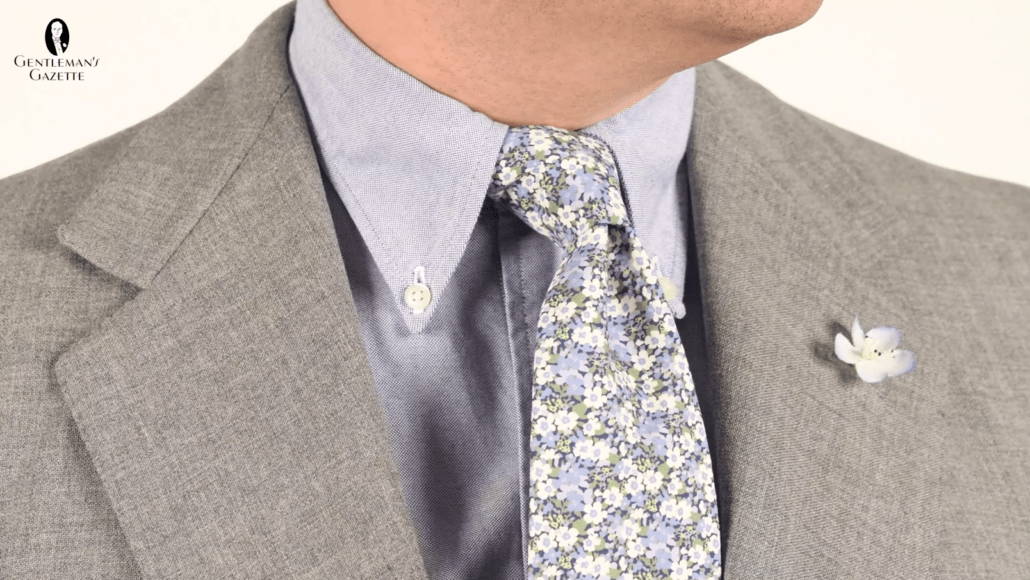
Yes, men’s clothing has absolutely also undergone a certain transformation if you compare the Armani blazer from the 80s with the padded shoulders, the wider lapels, and the low gorge, and a jacket that was slightly longer to for example something in 2020 that is much shorter, cut trimmer, and with no shoulder padding–there’s certainly a variation that’s visible. Comparing it to women’s clothing where you go from super oversized pants to super skinny pants, it’s just a wider spectrum and because of that, it’s less timeless and therefore, not classic.
Furthermore, women’s clothing has mostly been designed to be less practical but more ornamental and it lends itself to just being more extreme. Just think about the corset, for example, or the bustle, or the 1950s flounced skirt.
Reason #4: Women Have A Broader Wardrobe Today
In the modern world, ladies have a much broader and more varied wardrobe than they used to. In the 1950s, men would wear suits to the office and women would wear dresses or skirt sets.
Today, anyone can wear anything but unlike men, women’s clothing options have expanded dramatically in the sense of what garments women can wear and combine according to mainstream culture. Many of those garments originally stem from the menswear realm, just think about the biker or motorcycle jacket, work boots, or a blazer.

However, the crossover in the direction from the women’s world to the men’s world is very limited now. This means that in conventional terms, women have a much broader spectrum to pick from which makes it much harder to pick a classic because trends are generally more short-lived.
Reason #5: Womenswear Garments Tend Not To Last Long
Last but not least, the average quality in women’s wear is much lower than menswear which makes it much more difficult to find a garment that will actually be able to physically stand the test of time. No matter if you look at a cashmere sweater, a pair of socks, or jeans, generally, the quality level in women’s wear is much lower.
So, what does “low quality” mean in this context? Well, first of all, it starts with the fabrics. Oftentimes, women’s fabrics are all polyester or nylon and if you find wool or cotton or cashmere which is something that you typically find more in menswear, then they’re heavily blended. These two materials simply pill more easily and they attract stains to remain more permanent in the garment and just age more poorly which is a reason why you simply don’t want to wear them for that long.
That then begs the question: why is the quality in women’s wear so much lower than in menswear on average? Well, it has to do with the expectations and how long it will be worn. Traditionally, there was a fall-winter season and the spring-summer season. Well now, we also have resort season and pre-fall season and things turn around much more quickly, and with the advance of fast fashion, there is an interest to produce less expensive garments that can be worn once or twice and then thrown away or donated.
With consumers being happy that they have to pay less for garments than they had to 40 years ago and the ever-changing seasons, there’s simply no reason for manufacturers to invest in quality anymore. At the Gentleman’s Gazette, though, we’ve always been very focused on high-quality items because the classic style in itself requires you to have a high-quality garment because a blazer or a suit with a really nice silhouette that pills and are not colorfast isn’t really a great option.
So, in our opinion, these are the reasons why classic style for women doesn’t really work for better or for worse. That’s also the reason why we have zero intentions to create a Lady’s Gazette. We stay in our lane and focus on classic gentlemen’s style and lifestyle.
Classic Women’s Style Resources
I want to acknowledge that, again, we are not experts in the realm of women’s style or classic women’s style and that there are better places to look for information on the matter.
Women’s Style Channels
If you’re interested in vintage women’s fashion and fashion history, check out the channel of Karolina Zebrowska.
If you’re more interested in foundational topics such as styling, combining, recognizing quality or fashion history, check out the channel of the French fashion designer Justine Leconte. To my knowledge, French fashion is often considered to be more effortless and therefore classic and so, Justine’s take is particularly valuable if you’re more interested in quality and the classic side of things.
If you want to be inspired as a woman and know how you can incorporate classic men’s clothes into your wardrobe, I suggest you check out Sonya Glyn from Sartorial Talks. She does a fantastic job of wearing classic men’s suits but with a very feminine note that really suits her style.

Other great channels we’ve found (including some suggested to us by viewers!) include those of Audrey Coyne, Alyssa Beltempo, Shirinatra and Marie-Anne Lecoeur.
Ladies, a book by Claudia Piras & Bernhard Roetzel
There is also a book about classic style for women called Ladies, authored by Claudia Piras and Bernhard Roetzel who himself is well known for writing the book Gentleman. If you look at the original editions, they very much look alike. The content is very similar but the Gentleman’s version has been translated into many languages and has been republished in many different editions, whereas the Ladies’ version is still from 2003. In this book, some things may look a bit dated today, but there may be a thing or two that works for you and that you would enjoy.

So, these are our reasons for not covering classic women’s style, and why you most likely won’t be seeing a “Lady’s Gazette” from us. Still, if someone else is up to the challenge, we’ll be the first to support them!
What are your thoughts on the concept of “classic women’s style?” Let us know in the comments!
Outfit Rundown
I’m wearing a very classic men’s style outfit. It consists of a navy blue suit with a medium white lapel, two buttons and flap pockets in a fabric that is neither too thin nor too thick. I could have easily worn it 30 or 40 years ago and it doesn’t look dated today.
My shirt is a Winchester shirt with a club collar that is rounded and blue and white stripes. I’m combining it with a vintage tie that is orange and it has small micropatterns on it. Just like Prince Charles, I added a pocket square that picks up the white color of my shirt.
My pants match the jacket which is why it is a suit. My cufflinks are gold with amber, they’re probably 50 or 60 years old but I don’t look dated and I’m pairing it with a yellow citrine ring in yellow gold. Likewise vintage, but doesn’t look really dated at all.
For my shoes, I chose a black pair of leather half brogue oxfords which work with the suit and to provide a bit of contrast between the pants and the shoes, I wore a pair of two-tone solid socks from Fort Belvedere which have a kind of whitish and navy blue tone to them. They have a nice sheen; they provide contrast; you have to tie everything together without standing out too much.
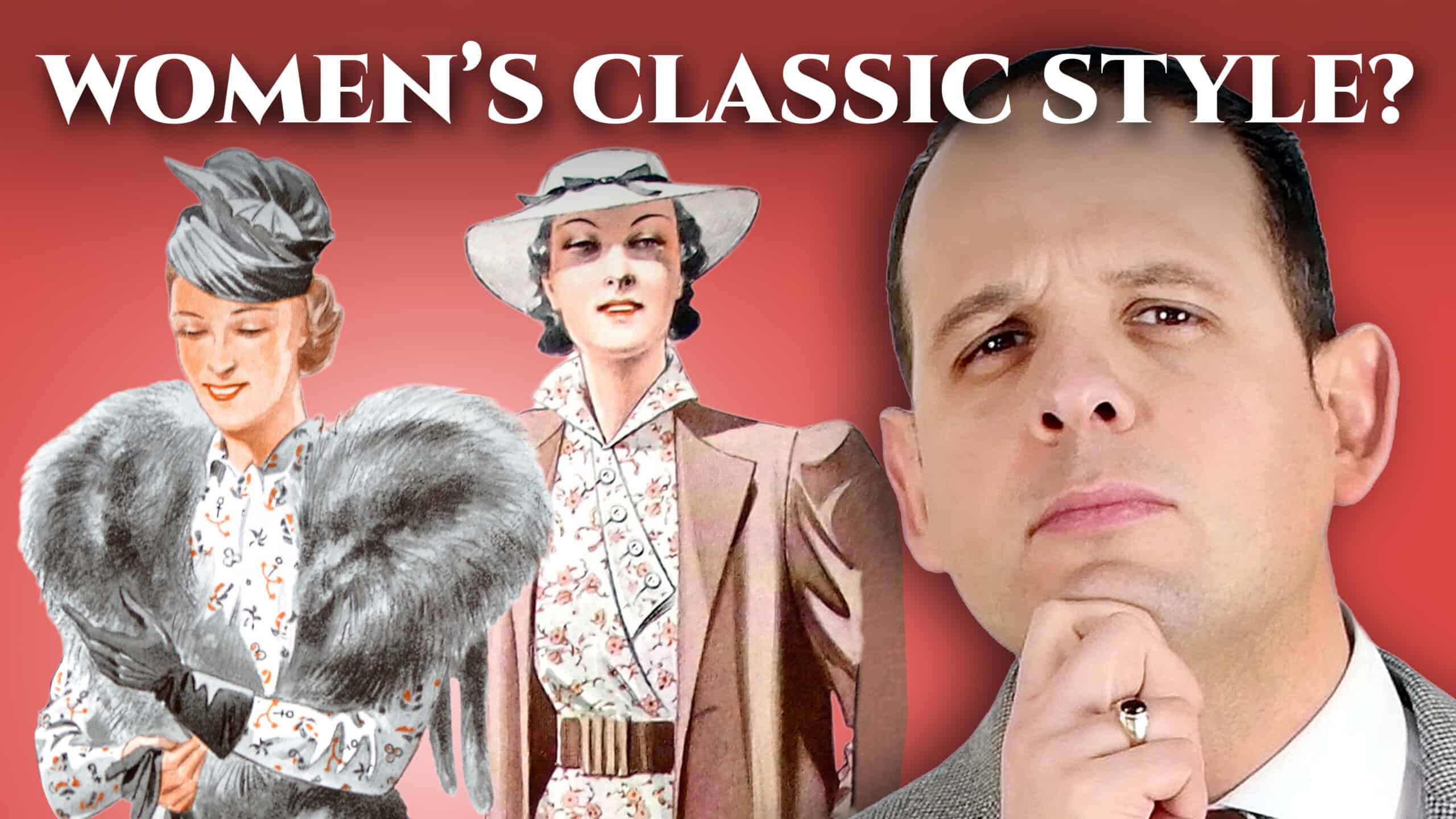


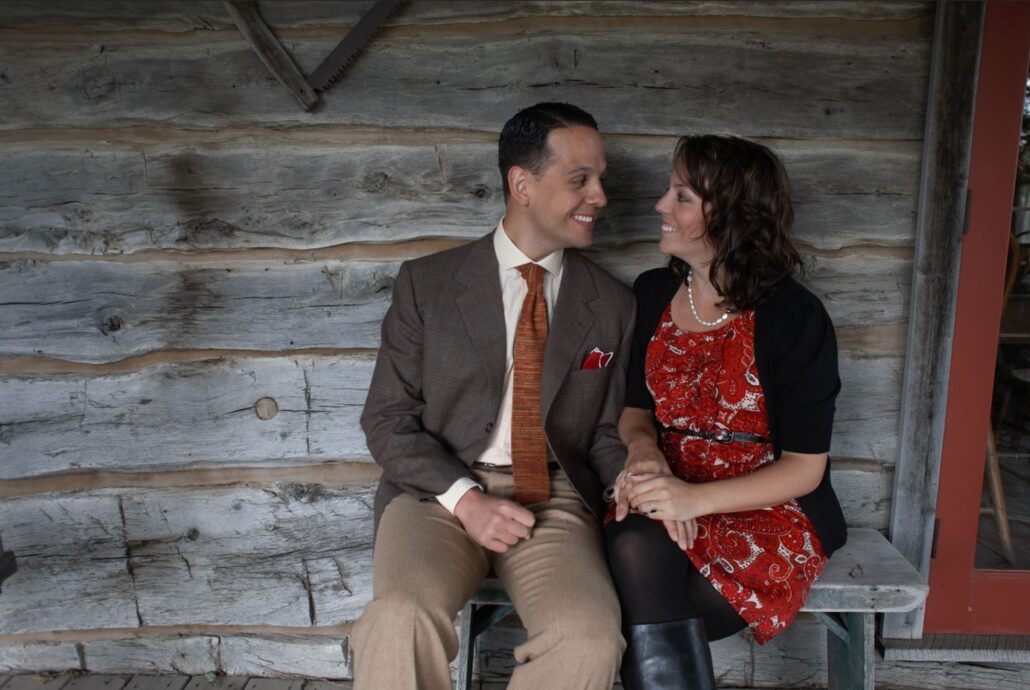
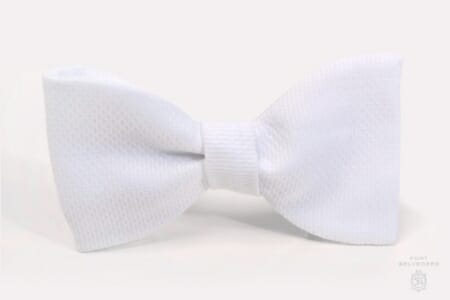

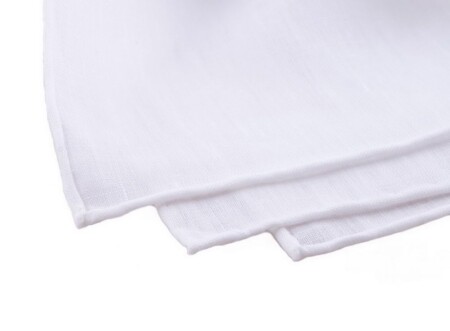
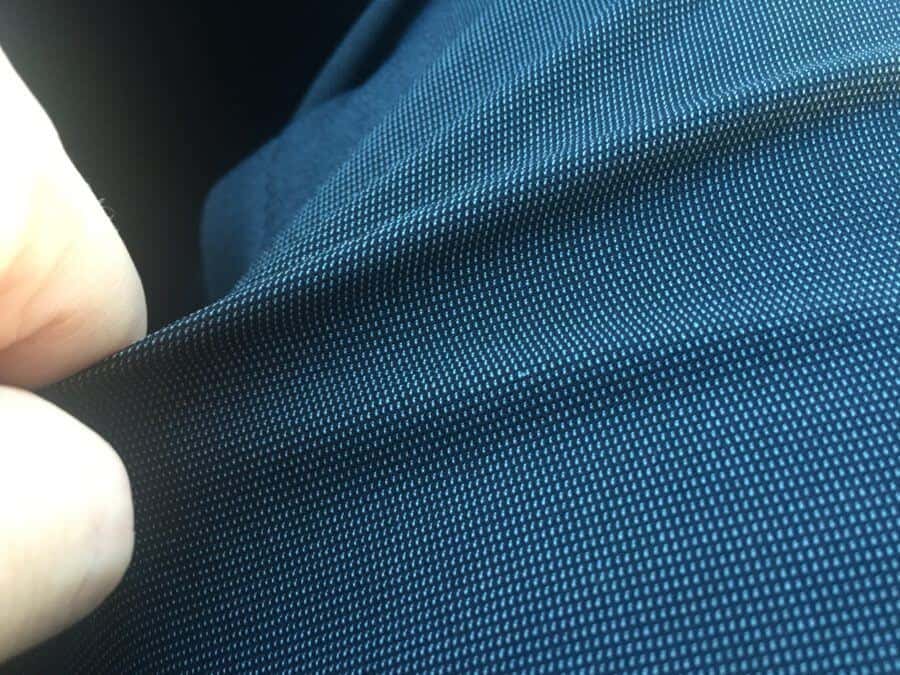
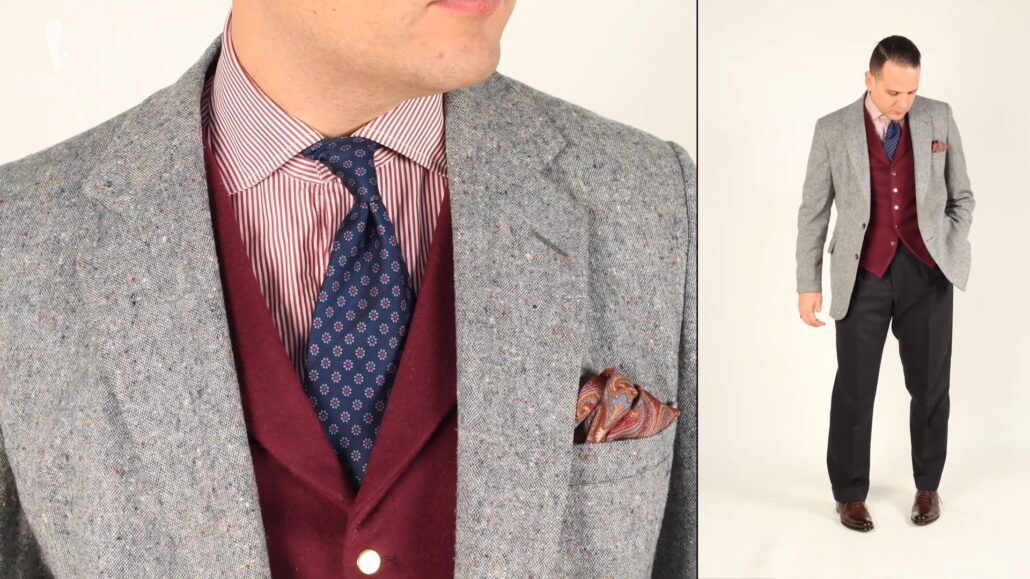
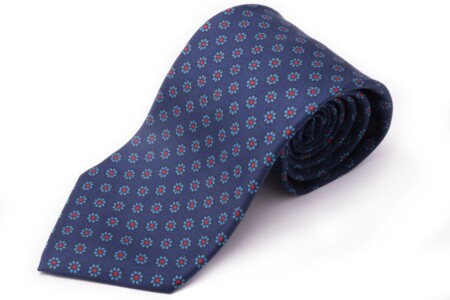
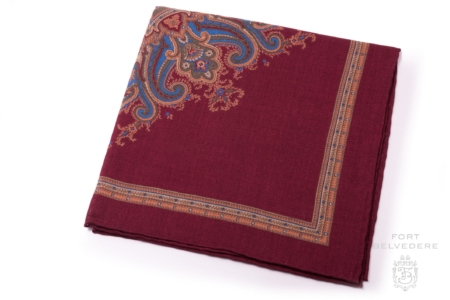


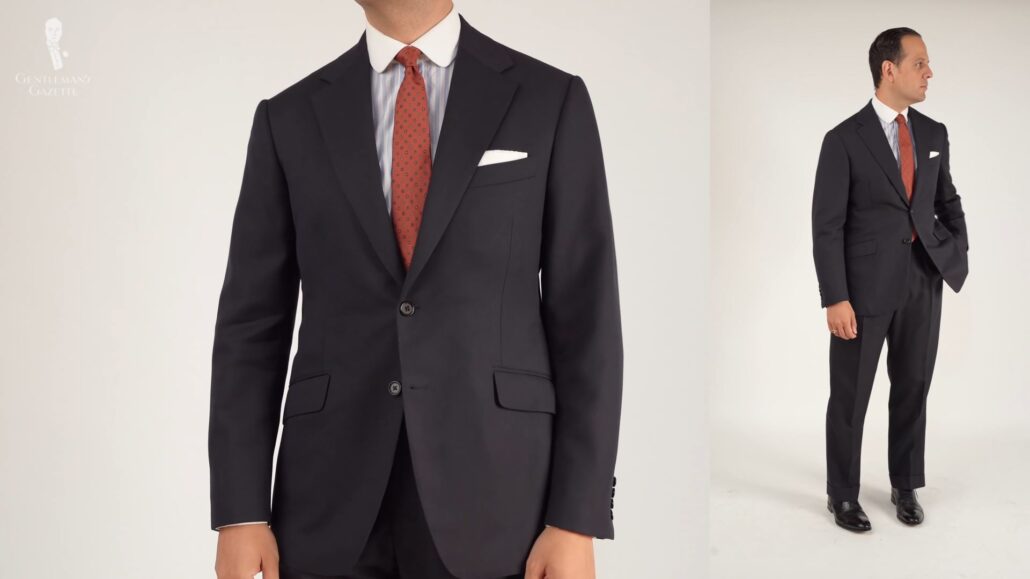
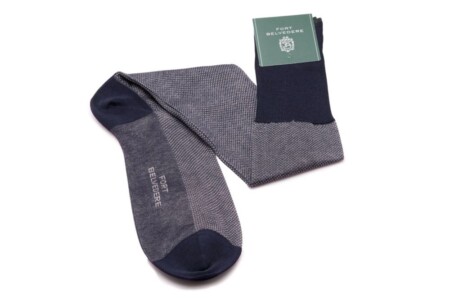
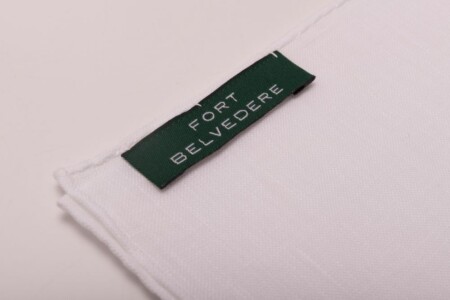
Thanks!
My wife was asking me the same just this week
I will look forward for your recomendations
I agree, women’s styles are ever changing, while men’s (classic style) fashion has pretty much remained the same for decades. If you need an illustration, next time you watch an awards show, (Oscars, Emmys) compare the women’s fashions and the men’s. The women’s are more current to the moment, while the men, (in most cases) are in black tie. This changes, of course, if the award show is the MTV awards. Then anything goes. .
> The women’s are more current to the moment, while the men, (in most cases) are in black tie.
Indeed. I forget who said it but a famous woman designer once observed that the only real question about a man’s wardrobe was whether to have satin stripe down the pants leg.
Don’t even try to go there. Danger Zone. Women are way too ‘particular’ and ‘fussy’ when it comes to clothing. (Let alone style). Just ask your local DryClean Shop why they charge ladies ‘double’ in many cases, from what charge us guys.
Excellent article! Correct on every point listed. Women’s clothes change not only every year, but seasonally. Yes, men’s clothes also, however not to the level that women’s fashions change. That’s not to say I wouldn’t mind every once in awhile to hear a women’s point of view on men’s attire.
As a woman who does not aspire to Classic Style (although I do enjoy of on other people) I find GG an invaluable resource none the less. I love the well researched history behind different types of garments and brands. I love the explanation about different types of garments/shoes construction and manufacturing. I love the etiquette and lifestyle advice. I find Fort Belvedere a good resource for gifts. The list goes on… While I don’t aspire to a female version Classic Style, I do aspire to timeless style, which, regardless of one’s aesthetic, is rooted in the emphasis on quality, deep knowledge, and not being dictated by trends. In this regard GG has plenty a lot to offer a woman like me and we have plenty in common.
Thanks for sharing Terr, and we’re thrilled you get all that value from us!
I’d also add Bernadette Banner to your list of suggested channels at the bottom! She works to recreate vintage ladies’ garments, particularly from the Edwardian and Victorian eras, using contemporary methods. I find her to be a knowledgeable and fascinating fount of classic women’s sartorial miscellanea.
Thanks for sharing, Maxwell! We’ll definitely check her channel. :)
I think classical womens fashion is more about a tasteful look than anything else. I agree that womens fashion changes to rapidly and to some extremes. But I do think some things remain timely. I couldn’t tell anyone what a tastefully dressed woman should wear, but certainly pay attention when I see it.
Excellent article. And may I say, your beautiful wife modeled the Marlene Dietrich look amazingly. She honestly looks like she could be a model. Thanks for all your expertise! It has been greatly appreciated for many years now.
Thank you, Ted! Teresa will be delighted to hear about this. :)
Dear Raphael,
I can not find your new two-tone socks in the GG shop?
Hi Peter! Yes, it’s still not in the shop but it will soon be available. :)
Greetings,
Men are in greater need of sartorial advice.
Well, this man is!
Best regards,
Andrew Gregg,
Palm Springs, CA
I have to disagree on this one. In public, I’ve seen many women who are in greater need of sartorial advice than men. NB: Comments to follow are NOT intended to shame women for showing skin or for their bodies. Rather, I tend to agree with many points Sven Raphael Schneider’s article ‘9 Reasons Dressing Down is Overrated.’ First of all, going about in sweatpants, hoodies, Daisy Dukes that barely cover their rear ends, leggings that are so thin they show their underwear and form fitting tops makes them look lazy in the same way that men do dressed in sweatpants, hoodies, cheap joggers with everything, long slung ripped jeans, etc. When it’s in environments like retail customer service, they look particularly unprofessional.
Similarly I’ve seen articles about women who’ve been slammed for turning up to occasions like weddings in dresses that are too tight and short like these: https://www.nzherald.co.nz/lifestyle/news/article.cfm?c_id=6&objectid=12287348
https://www.thatslife.com.au/wedding-guest-hits-back-over-body-shaming-of-trashy-dress
Again, I tend to agree with Sven Raphael Schneider in saying how you dress isn’t just about you; dressing well is also about showing a mark of respect for others. In the above examples, for the bride and groom.
Very well said! Thank you for sharing your thoughts!
I know just what you mean about womens’ clothes being of lower quality than mens’. All of my female relatives complain about this; namely, things like t-shirts being too transparent due to thin low quality fabric, necklines being far too low (one goes as far to say it’s because they’re designed by men for their appreciation) and often too tight. Or that casual wear such as hoodies are too narrow in the shoulders where they’ve inherited the broad shoulders from their father’s side of the family. The whacky theory the men have come up with: it’s due to the sexist assumption that women are shopaholics (whereas we guys see it as a chore) so clothes are deliberately lower quality to give women excuses to go shopping for more Instead the women in my family mostly opt for buying things mens’ t-shirts, hoodies, etc
I agree…isn’t it such a wacky theory! There are so many better excuses for the horrible quality that is women’s clothing ( like how women are required to have more “changes” throughout the week, but we still have a significant pay gap) but really *none* of them hold any water. I have literally been wearing my grandmother’s clothing from 1950s and early 60’s (and occasionally some of my mother’s from the late 70s) as my career and formal wear. The high quality has allowed it to be passed down to me, and silhouettes are just as appropriate now. I do really appreciate Sven and Teresa knowing their limits, but it would be great to see someone notice that there are distinct silhouettes, fabric choices, and quality that have guided all of women’s fashion since WWII – when women really started entering the workforce and politics, and we started to become more than just ornaments.
Merci Sven, I am very honoured to be mentioned amongst such illustrious company in ladies’ style
You are welcome Marie-Anne!
I very much appreciate that you are committed to advocating for, perpetuating and educating people on classic men’s style and the gentleman’s lifestyle; undoubtedly your finest areas of expertise bar none. I have learned so much invaluable information from this website ever since I stumbled into the world of menswear and subsequent areas of interest several years ago and I have always since wondered about and sought a counterpart network for classic women’s fashion of equivalent calibre, of which I cannot say I have succeeded entirely and unequivocally. However,
I’ll have to disagree with some of the reasons and quite a few of the points raised in this article;
You stated that classic style does not work in the same way for women as it does for men; that much is true to an extent, although that does not mean that a classic style for women does not exist or otherwise eludes us – there are plenty of staple items which elegant, classically-minded women consider, possess and wear which can be strongly regarded as classic and timeless. There are plenty of classic items for women just as much as for men; a basic dress as can a skirt can come in several more or less fundamental variations just as a gentleman’s jacket or coat – the sheath dress, halter dress, shirt dress and ball gown is to your two-piece suit, blazer, dress shirt and chinos and tuxedo. A little black dress (LBD) can come in several cuts, fabrics and silhouettes, as can a man’s suit does in cut, fabric and style. While perhaps not having as long a history compared to menswear staples, there are definitely foundational garments and accessories that have stood the test of time in a woman’s wardrobe. For this, I elect the classic pencil skirt, which came about during the mid 20th century; it has been a staple for fashionable women and working ladies for the better part of over 65 years. In the same vein, the woman’s suit, dress, hats, gloves, boots, stockings, perfume and the court pump in one historical variety or another have stood the same test of time for just over a century and have become classic staples in their own right. These items are among the many that make up the backbone of the classic womenswear repertoire; it is not too difficult to imagine further, as well as the classic men’s counterparts and their many, many varieties. A skirt and a blouse will be, what it was in the 1920s, 1940s and ’50s, in the 1980s and today with few exceptions – a timeless, largely unchanging classic staple of women’s style, as a suit, dress shirt and trousers would be in any era, for men. No doubt many of these have largely fallen out of style with much of the general populace nowadays as with classic menswear, yet a dress is still a foundational garment for women, as a suit is for men. There are countless men today who would not even dwell on wearing a suit, dress shirt, or dress shoes as a woman today would not even think of wearing a dress, skirt or pumps. Yet many a classic-minded, life-savvy or conservative person would, and thus it can still be very much considered a foundational garment. Despite most men not wearing three piece suits, ties or fedoras in our current time, you would still consider them classic menswear staples. The same would apply to a dress, skirt or any classic womenswear staple which has endured for several decades.
As for the golden era of women’s fashion as subjective as it is, I would say that the 1940s and 1950s again would be the closest to an unequivocal candidate. Many of the modern silhouettes and styles you see in subsequent decades and today in womenswear have their origins in this era and there is a reason why drawings of this era adorn the cover of books, the walls of some ladies’ ateliers and is the first thing people think about when they think of classic women’s fashion. The “New Look” of 1947 of Christian Dior fame is quite often said to have revolutionised women’s fashion and takes prime position in a timeline of many of the paradigm-shifting trends that have hit the scene within a century. Nothing close comes today to being so influential in the world of women’s fashion as these pivotal moments in history. People look back fondly at this era as the golden era; women, when they do, undoubtedly look back on this era as the golden era of women’s fashion, given no other alternatives.
The origins of the modern era of women’s fashion can be traced back to the 1930s, although I would go as far back as the 1920s; this is when the first modern styles appeared, contrasted with the previous century, the fashion of the 19th century which largely influenced fashion until the 1920s. Yet again the modern styles we know today, mostly originated in the 1940s and 1950s; the pencil skirt, A-line dress and pencil dress being prime examples. Menswear today is also a mix of styles that have appeared in the last 70-100 years or so. As you’ve said, pants could be considered by at least some to be foundational for women, as could a skirt or a dress, but I’m sure nearly all women today would base their outfit around a pair of pants, shorts or a skirt, if not the slightly less likely but still very common dress. I cannot imagine the average woman today not wearing a pair of pants, shorts or a skirt as a primary garment in typical western society. If women have been wearing these garments as their primary staple for nearly a century if not a whole century, I would say you could certainly call it foundational and thus forms the strong basis of your classic womenswear. A skirt or a kilt would not be typically foundational for a man, but a a skirt, a pair of pants or even a pair of jeans would definitely be for a woman.
Yes, there is less variation among menswear based on traditional wardrobe staples, and there is a lot more variation among womenswear in all clothing items for women, including the aforementioned classic staple items but that does not mean there are very little or no classic staple items for women or garments, outfits and styles which are strongly considered timeless. There are very noticeable constants and uniformities among women’s garments over the century up until today, notwithstanding any wild fluctuations in current trends and preferred fashions. As I’ve said earlier, a skirt or a blouse, or even a dress is what it was 70, 60, 50 years ago today. Many would consider certain dress designs to be timeless and classic. As there are many womenswear options that derive from menswear, there are at least an equal amount if not vastly more women’s clothing items that are exclusively in the domain of women that many a man would not even think of wearing. Despite this, and perhaps because of this, there are again plenty of items for women that could be considered, claimed and cherished as timeless classics, which cannot be shared with menswear as it does for womenswear.
Lastly, despite women’s fashion in particular being very seasonal and trend-based, and thus the clothing items are made to last a lot less longer, that still does not mean that womenswear again does not have classic, timeless wardrobe staples, or even simply a considerable amount of high quality items worth considering. There are a good number of exclusive, exquisitely crafted items for the discerning lady if one knows where to look. The game is often different for women as it would be for men, but that doesn’t mean it’s not worth playing.
I hope this offers something to the discussion that is worth considering; I will always treasure the Gentleman’s Gazette for providing such a rich source of knowledge and inspiration for timeless, classic menswear. I hope this will not be the last mention of women’s fashion and the relationship between womenswear and menswear; certainly as much as you I would welcome the creation and development of a ladies’ website of equal calibre, as much as I can envision this place becoming a Ladies and Gentleman’s Gazette.
Sincerely,
– Kay McAllister
That’s a massive comment Kay, thanks for providing so much food for thought. I agree, nothing has to be that way, which means there is room for a brand to fill that niche I suppose, it just won’t be us!